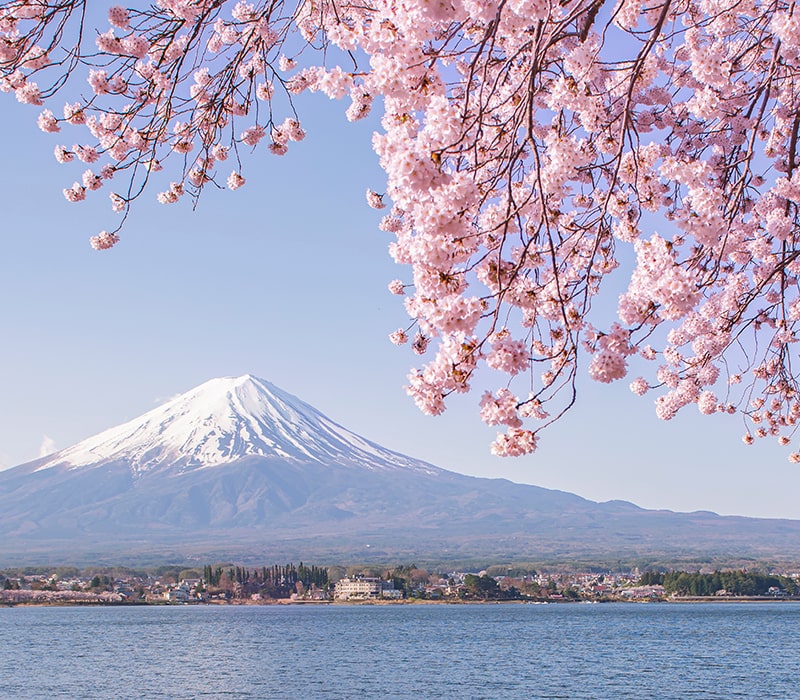In the quest for the quintessential travel experience, Japan is a beacon of cultural richness and diverse landscapes. If you’ve ever wondered about the best things to do in Japan, you’re in for a treat! This country is like a beautifully wrapped gift box filled with surprises that never fail to delight its visitors.
Maybe you’ve visited Japan before and are hungry for new immersive experiences, or perhaps you’re just starting your travel planning for a dream adventure. Wherever you are, this guide is here to support, inspire, and reassure you—offering trusted guidance and expert local insight. Together, we’ll explore not just the top tourist spots, but the soul of Japan: the places, tastes, and moments that become your favourite experiences, again and again. So, are you ready to dive into this vibrant kaleidoscope of experiences with Designer Journeys? Let’s unwrap this gift box together!
Post Contents
When Is the Best Time to Visit Japan?
Choosing the best time to visit Japan depends on the experiences you dream of, your favourite climate, and your travel priorities. Every season offers something unique—and each can transform your journey into an unforgettable experience. This is the full review of each season.
- Spring (Late March–May): This is cherry blossom season, when sakura cherry blossoms turn cities and countryside pink and white. Hanami (flower-viewing) picnics beneath blooming trees are a favourite experience, and mild temperatures make it ideal for exploring cities and gardens. Book early—this is peak season!
- Summer (June–August): Japanese summers are hot and humid, but they bring lively festivals, fireworks, mountain hikes, and even beach escapes. Hokkaido and the Japanese Alps are incredible retreats, and summer is perfect for scuba diving in Okinawa or the Izu Peninsula.
- Autumn (September–November): Autumn in Japan is a photographer’s dream. The country transforms into a vibrant tapestry of red and gold foliage, and the air is crisp and clear. Kyoto’s temples, Nikko’s mountains, and city parks are all spectacular.
- Winter (December–February): If you love snow, Japan’s ski resorts in Hokkaido and Nagano are world-class. This is the best time to experience hot springs (onsen experiences), spot snow monkeys, and enjoy fewer crowds at top sites. Illuminations and winter street food make big cities magical.
Expert Insight: For most travellers, late March to mid-April (cherry blossom season) or November (autumn leaves) are the ultimate times to visit Japan for scenery, weather, and immersive experiences. However, each season offers its own unique magic—so design your trip around what inspires you the most.
How To Use This Japan Bucket List From Designer Journeys
This isn’t a one-size-fits-all itinerary — it’s a curated menu of extraordinary Japan experiences. Here’s how to make it yours:
Step 1: Scan the complete list and star ★ experiences that resonate with your travel style
Step 2: Note seasonal timing — some experiences are season-specific (cherry blossoms, snow festivals)
Step 3: Consider your trip length — 7 days? 14 days? 21 days? We’ll show you how to prioritise
Step 4: Balance iconic with hidden gems — mix must-sees with local designer recommendations
Step 5: Connect with a Designer Journeys Japan specialist to weave your starred activities into a seamless, personalised itinerary
Every experience below includes: what makes it extraordinary, best timing, local designer insights, and how it connects to other activities.
25+ Extraordinary Things To Do in Japan: The Complete Bucket List
Iconic Cultural Experiences
1. Visit Kyoto’s Gion District and Geisha Culture
Gion, Kyoto’s most famous geisha district, is characterised by its traditional wooden machiya houses, teahouses, and exclusive ochaya (entertainment houses). As you wander the atmospheric streets, watch for geiko (Kyoto dialect for geisha) or maiko (apprentice geisha) in their exquisite attire. Visiting Gion is like stepping into a living museum, offering a glimpse into the secretive world of geisha and the enduring customs of old Kyoto. It’s a highlight experience, providing insight into the geisha tradition’s traditional art, beauty, and discipline.

Gion District is like a living museum.
2. Indulge in Japanese culture with a Tea Ceremony
The Japanese tea ceremony, known as Chanoyu, Sado, or simply Ocha in Japanese, is a choreographed ritual of preparing and serving Japanese green tea, called matcha (green tea), together with traditional Japanese sweets to balance the bitter taste of the tea.

Tea Ceremony is one of the things to do in Japan.
This ceremonial practice is more than a drink-serving ritual; it’s a spiritual and philosophical experience embodying harmony, respect, purity, and tranquillity — principles collectively known as “wa-kei-sei-jaku.” Engaging in this is a profound way to connect deeply with culture, history, and aesthetics.
The roots of this ritual stretch back to the 9th century, but it was in the 16th century, under the influence of tea masters like Sen no Rikyu, that the practice evolved into its current form. This ritual became a way to appreciate the simple and the refined, embodying Zen Buddhist philosophies. During this time, the tea room, utensils, and kaiseki (a meal served before the ceremony) became integral, each with significance and aesthetic value.
Expert Tip: Book a session with an English-speaking expert for a deeper cultural immersion experience.
3. Visit Fushimi Inari Shrine, Kyoto
Fushimi Inari Shrine is an iconic sight in Kyoto, most famous for its thousands of vermilion torii gates that trail into the wooded forest of the sacred Mount Inari. Walking through the seemingly endless arcades, there’s an even more jaw-dropping sight around every corner. The shrine is dedicated to Inari, the Shinto god of rice, and foxes are thought to be his messengers, resulting in numerous fox statues across the shrine grounds. Climbing the mountain paths provides a spiritual journey and stunning views of Kyoto below.

Thousands of vermilion torii gates that trail into the wooded forest of the sacred Mount Inari.
4. Visit the Golden Pavilion in Kyoto
The Golden Pavilion, or Kinkaku-ji, is one of Japan’s most iconic and celebrated temples in the historic city of Kyoto. Officially named Rokuon-ji, the temple is a Zen Buddhist structure renowned worldwide for its striking beauty and the detailed history behind its construction and subsequent existence. The Golden Temple’s top two floors are entirely covered in gold leaf, reflecting the sunlight and surrounding natural beauty in a dazzling display of luxury and artistry.

Golden Pavilion, or Golden temple is one of the most iconic temples in Japan.
The design of the Golden Pavilion integrates three distinct styles of architecture – Shinden, Samurai, and Zen, each represented in its three floors. The first floor, The Chamber of Dharma Waters, is designed in the Shinden style, typically used for palace buildings during the Heian Period. The second floor, The Tower of Sound Waves, reflects the samurai or warrior aristocracy style. The third and top floors, known as The Cupola of the Ultimate, are designed in the traditional Chinese Zen Hall style, capped with a golden phoenix.
Expert Tip: As one of Kyoto’s most visited temples, Kinkaku-ji is always bustling with tourists. Early mornings or late afternoons might offer a slightly more peaceful visit.
5. Visit Todai-ji Temple & Feed The Deer in Nara Park
Nara Park is famous for its hundreds of freely roaming deer, considered messengers of the gods in Shinto. You can feed the deer with special crackers sold around the park. The park is also home to significant temples and shrines, including Todai-ji, which houses a giant Buddha statue. The combination of cultural heritage and natural beauty makes Nara Park a peaceful and fascinating place to visit.

Feed the deer in Nara Park is one of the things to do in Japan.
6. Visit Hiroshima Peace Memorial
The Hiroshima Peace Memorial Park is a poignant reminder of the devastating effects of nuclear warfare. At the heart of the park stands the Genbaku Dome, the only structure left standing near the bomb’s hypocenter. Visiting the park and its museum provides insight into August 6, 1945, and the subsequent impact on the city and its people.
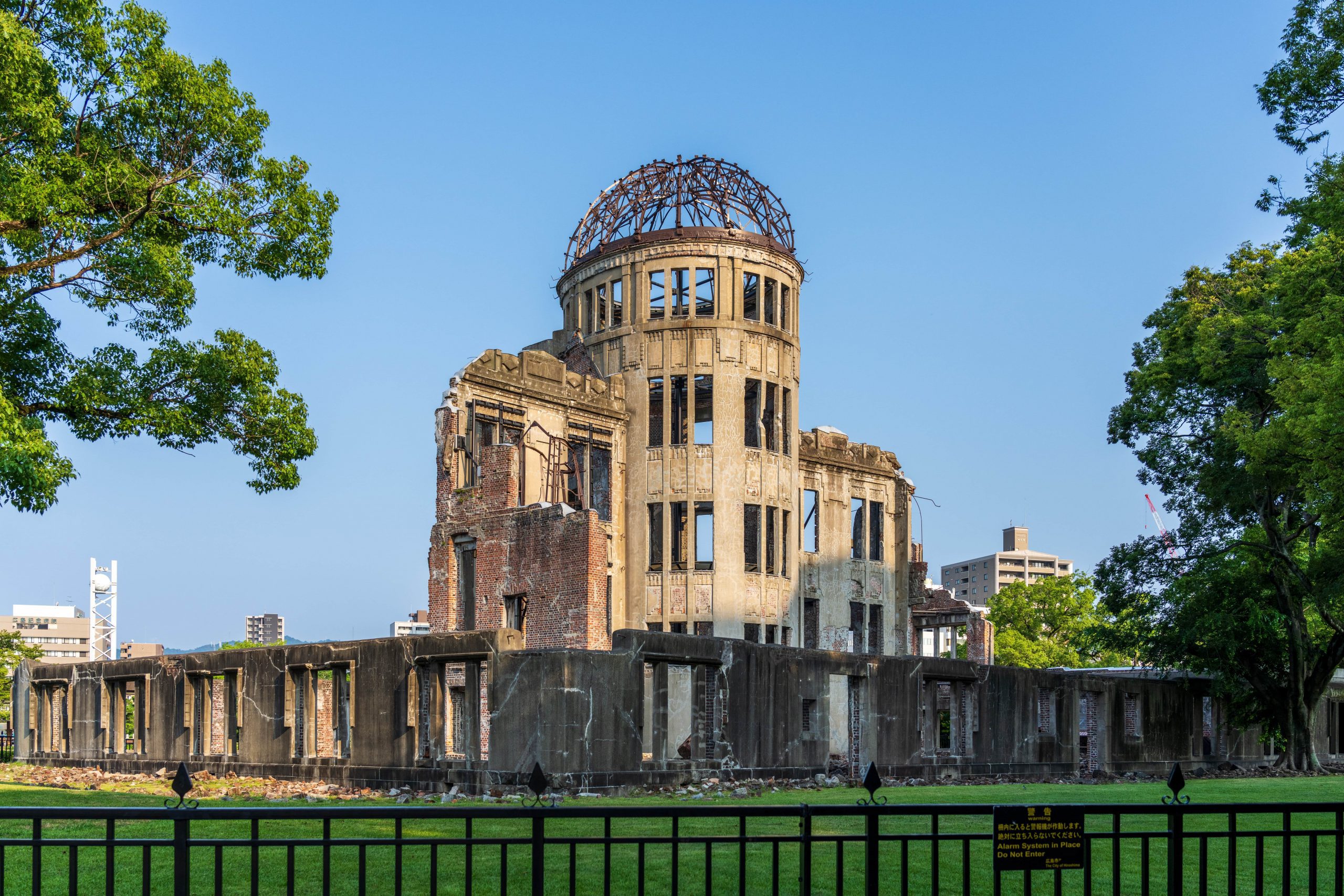
Atomic Bomb Dome in Hiroshima Peace Memorial Park.
Nearby: Don’t miss the Peace Memorial Museum and the Children’s Peace Monument.
7. Explore Osaka Castle
Osaka Castle is one of Japan’s most famous landmarks, embodying the country’s history and architectural beauty. The castle has been a focal point of several historical events and now serves as a museum showcasing artefacts and telling the story of Osaka. The surrounding park blooms with cherry blossoms in spring, offering a pleasant escape from the urban environment. The view from the top of the castle provides a panoramic view of Osaka, blending the past and present.

Osaka Castle is one of Japan’s most famous landmarks.
8. Visit the Himeji Castle
Standing majestically atop a hill in the city of Himeji, Himeji Castle is Japan’s most celebrated and best-preserved samurai fortress—a living work of art, and an essential experience on any ultimate Japan bucket list. Nicknamed the “White Heron Castle” (Shirasagi-jo) for its elegant, wing-like rooflines and brilliant white walls, this UNESCO World Heritage Site blends formidable military design with a sense of airy, timeless grace.
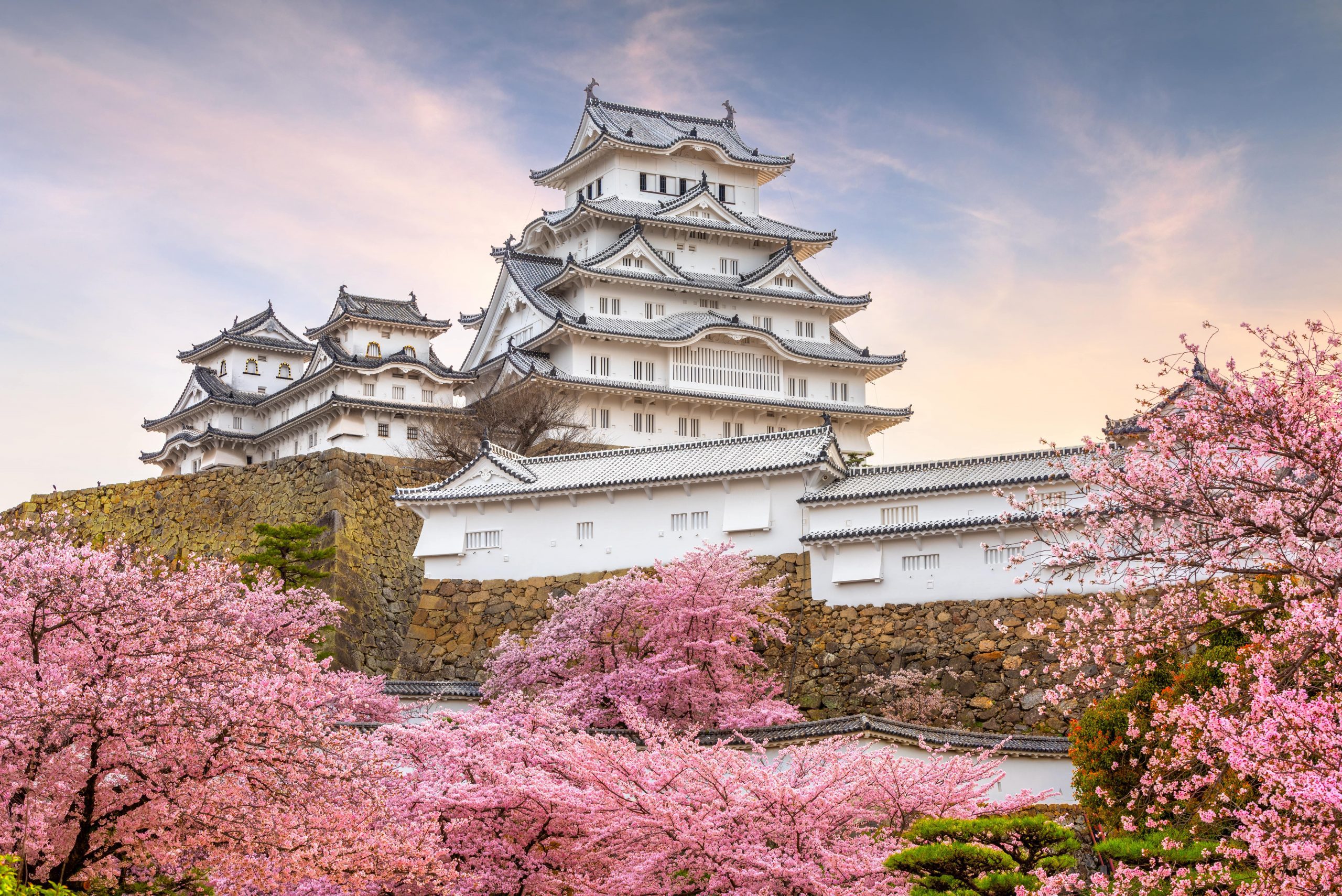
Himeji Castle in Spring.
In spring, over 1,000 cherry trees burst into bloom, framing the white walls with clouds of pink. Autumn’s golden foliage and winter’s rare snowfall each offer unique photo opportunities and moods, making Himeji a castle for all seasons.
Expert Tip: Combination tickets often include the castle and Koko-en Garden, just next door—a beautiful samurai-style garden with tea houses and tranquil ponds.
9. Visit Meiji Jingu Shrine
Another essential stop for any ultimate Japan bucket list, Meiji Jingu Shrine is dedicated to Emperor Meiji and Empress Shoken. Walk through massive torii gates into a tranquil forest and join in traditional rituals.
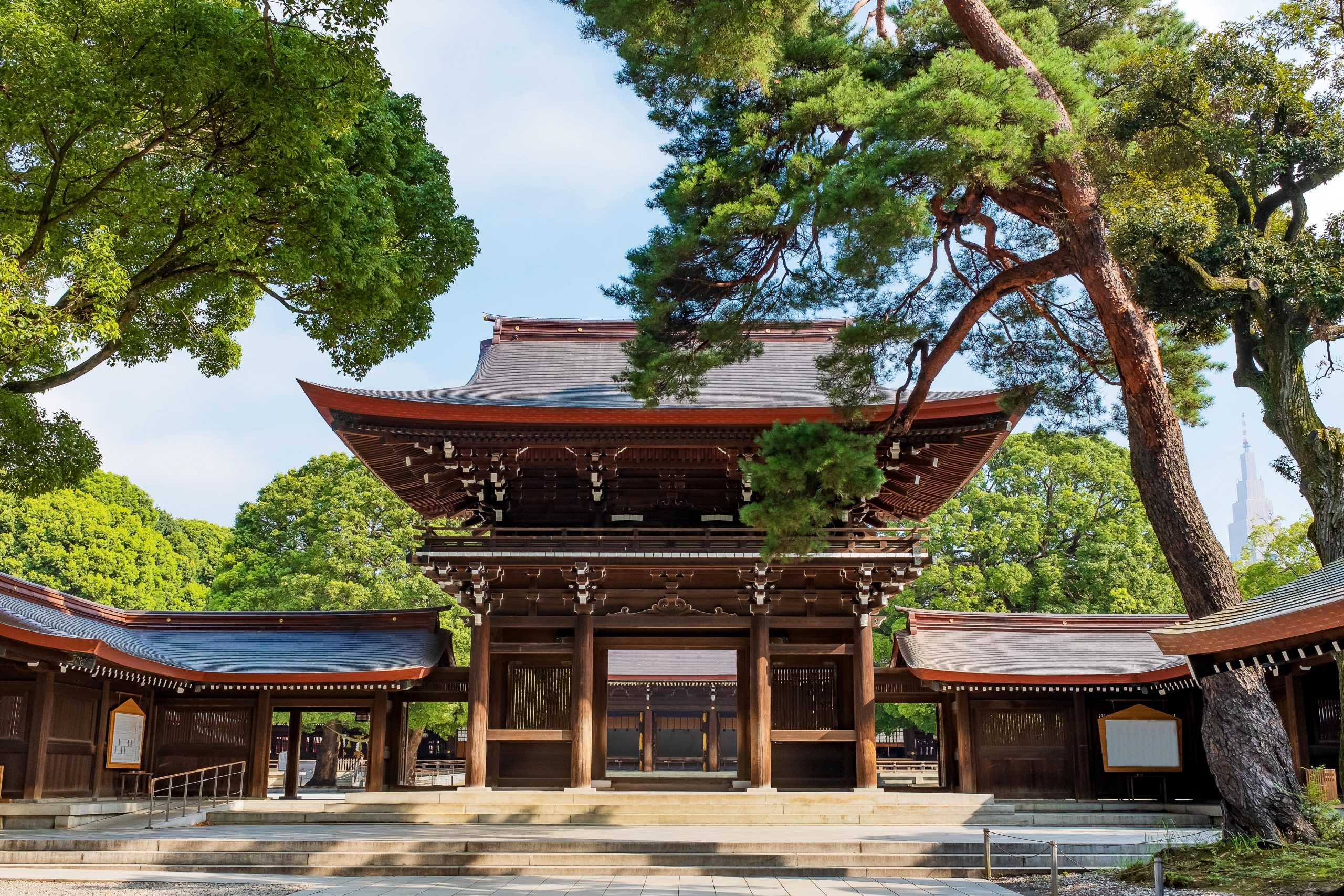
The Meiji Jingu Shrine area in Tokyo.
Expert Tips:
- When to Visit: Early mornings offer the quietest experience. Weekends and public holidays can be busy, but the crowds add energy, especially during festivals.
- Combine Experiences: After exploring the shrine, wander into nearby Yoyogi Park, explore the trendy shops and cafés of Harajuku, or take a short trip to the Imperial Palace or Shibuya Crossing for more big-city adventures.
10. Visit the UNESCO World Heritage Town of Takayama
Nestled in the mountainous Hida region of Gifu Prefecture, Takayama is a town that time seems to have forgotten, preserving the atmosphere of Japan as it was centuries ago. Known for its well-preserved Edo period (1603–1868) streets, this town is often called “Little Kyoto” for its historic charm and beauty. As one of the UNESCO World Heritage sites, Takayama offers a rare glimpse into the past with its beautifully maintained old town, traditional merchant houses, and sake breweries.

Takayama town is often called “Little Kyoto” for its historic charm and beauty.
Takayama is also famous for its biannual festivals, held in spring and autumn, which are known as one of Japan’s most beautiful. The Takayama Festival features large, ornate floats that parade through the streets, showcasing the craftsmanship and artistic heritage of the Hida region. These festivals are a vibrant testament to the town’s community spirit and cultural pride. The morning markets along the Miyagawa River are a must-visit, where locals sell crafts, snacks, and fresh produce, providing a lively and colourful start to the day.
Natural Wonders & Scenic Beauty
11. Visit Mount Fuji: The Soul of Japan
No Japan bucket list is complete without Mount Fuji, or Fuji-san. This perfectly symmetrical volcano is more than a scenic backdrop—it’s a national icon, an inspiration to artists, and a destination for countless unforgettable experiences.
Standing at 3,776 meters, its nearly perfectly symmetrical cone shape is recognised worldwide and has inspired artists, poets, and pilgrims throughout the centuries. Mount Fuji is not only a natural wonder but also a sacred site, embodying the spiritual essence of Japan. (Source: UNESCO)

Mount Fuji is not only a natural wonder but also a sacred site, embodying the spiritual essence of Japan
The official climbing season for Mount Fuji is from early July to mid-September, when the weather is mildest, and the snow has melted. There are four main routes to the summit, each with different difficulty levels and unique scenic views. Climbers often start their ascent in the afternoon, rest at mountain huts overnight, and reach the summit in time for the sunrise.
For those not looking to climb, there are numerous vantage points and attractions where one can appreciate the mountain’s beauty. On a clear day, take in the stunning view of Mount Fuji from the Tokyo Metropolitan Government Building. The Chureito Pagoda offers one of the most iconic views of Mount Fuji, especially stunning during the cherry blossom or autumn seasons.
12. Wander through The Magical Bamboo Forest, Arashiyama
The Arashiyama Bamboo Grove is one of Kyoto’s most photographed and famous sights, and for good reason. Walking through this towering bamboo forest offers a moment of complete escapism. The sun filters through the dense stalks, casting a soft, green glow that envelops you in an almost dreamlike atmosphere. The bamboo swaying in the wind is a natural symphony, adding to the sense of enchantment. The Arashiyama Bamboo Forest is a highlight of any Japan trip—an immersive experience in Japanese nature and design.

Arashiyama Bamboo Grove is one of Kyoto’s most photographed sights.
- Nearby Attractions: The area is also home to the famous Togetsukyo Bridge, traditional tea houses, and souvenir shops filled with local crafts.
- Best Time: Early morning for peaceful walks and beautiful photos.
13. See the Snow Monkeys in Jigokudani National Park
The Snow Monkeys of Jigokudani are a unique and endearing sight. These Japanese macaques are known for bathing in the park’s natural hot spring, especially during the snowy winter (ideally in early February). Observing their human-like behaviour and social interactions in the steamy waters is a captivating experience. The park’s rugged, snowy landscape adds to the magical atmosphere, making it a memorable excursion into Japan’s wild side.

Snow Monkey of Jigokudani are a unique and endearing sight.
Tip: Many onsen offer private baths for couples or families seeking a more personal experience.
14. Go diving on Okinawa Island
Okinawa, a tropical paradise in Japan, offers some of the best diving spots in the world. The crystal-clear waters and abundant marine life make it a diver’s dream. Explore the colourful coral reefs, encounter sea turtles, and swim among schools of tropical fish. Okinawa’s unique culture, distinct from mainland Japan, adds intrigue to your visit. Above water, the island’s beaches, historical sites, and Ryukyu Kingdom ruins offer more adventures.

Diving on Okinawa Island.
Urban Adventures & Modern Japan
15. Visiting Tokyo’s Famous Places
Tokyo is the gateway to Japan for most travellers—a buzzing metropolis that feels futuristic yet rooted in tradition. Visiting Tokyo is like stepping into a new country with each neighbourhood.

Tokyo Tower, a beacon of Modernity and Tradition
- Tokyo Tower: As you gaze up at the crimson-laced structure of Tokyo Tower, you can feel the pulse of the city’s heart. Standing at 333 meters, when you reach the top, this iconic symbol provides a panoramic vista of the sprawling metropolis below.
- Shibuya Crossing: This iconic spot is more than just a photo op—it’s a symbol of Tokyo’s energy and style. Stand here and watch as thousands of people cross from every direction, each on their own journey.
- Asakusa District & Senso-ji Temple: In the heart of Tokyo, Asakusa’s streets brim with souvenir shops, Japanese snacks, and traditional crafts. Step through the thunder gate to Senso-ji Temple, Tokyo’s oldest and most celebrated Buddhist temple, and soak in centuries of Japanese culture.
- Department Stores & Train Stations: Tokyo’s legendary department stores and train station food halls are the perfect place to explore Japanese snacks, shop for unique gifts, and try your hand at Google Translate when you encounter something mysterious!
Check out our guide for amazing things to do in Tokyo.
16. Go Street Karting in Tokyo
Imagine the thrill of navigating Tokyo’s streets, not as a pedestrian or passenger, but as a street kart driver dressed as your favourite Mario character. This unique experience lets you see the city from an entirely new perspective, feeling the wind’s rush and the streets’ buzz. Driving past landmarks and under the neon lights and signs, you’ll feel part of Tokyo’s slightly eccentric energy. It’s not just an activity; it’s your chance to live a moment straight out of a video game, creating unforgettable memories. This experience is one of the most highly rated amongst our travellers.

Street Karting – A Fun Thing to Do in Japan.
17. Visit a Karaoke Bar
Karaoke is a beloved pastime in Japan, offering a fun way to enjoy music and entertainment. Visiting a karaoke bar is a must-do activity, where you can sing your heart out in private rooms with friends or family. It’s a great way to experience modern Japanese, enjoy a wide selection of songs, and perhaps even practice your Japanese singing skills. From classic hits to the latest chart-toppers, karaoke bars provide an evening of laughter and bonding.

Karaoke rooms in Japan, where you can sing your heart out in private rooms with friends or family.
18. Experience the World-Famous Bullet Trains
Japan’s Shinkansen, or bullet trains, are not just a mode of transportation; they are an emblem of the country’s post-war resurgence and technological innovation. Introduced in 1964, the Shinkansen revolutionised travel in Japan, connecting distant and major cities with unprecedented speed and efficiency. Today, the network of high-speed trains spans the length and breadth of the country, offering travellers a swift, sleek, and comfortable way to explore Japan’s diverse landscapes and cities.

Riding the bullet train is one of the things to do in Japan.
The Shinkansen network is known for its punctuality, with departures and arrivals timed to the minute. This reliability and frequent service make it an incredibly convenient way to travel. Whether you’re heading from Tokyo to the historic city of Kyoto, exploring the northern landscapes of Hokkaido, or venturing south to the tropical islands of Kyushu, the bullet train makes these journeys smooth and enjoyable.
Expert Tips: Part of the joy of travel in Japan is how easy it is to take day trips by bullet train. So design your trip with flexibility (you can spend days exploring big cities, then escape to the countryside, mountains, or coast for a change of pace).
19. Visit Universal Studios Japan
In Osaka’s bay area, Universal Studios Japan (USJ) brings together the magic of Hollywood, Japanese creativity, and the latest in theme park innovation. For families, couples, solo adventurers, and anyone young at heart, USJ is much more than just a theme park—it’s an immersive, expertly crafted destination, and a must on any ultimate Japan bucket list.

Universal Studios Japan brings together the magic of Hollywood. Credit oasisamuel – stock.adobe.com
- Super Nintendo World: Race through Mario Kart, collect coins, and relive childhood memories.
- Harry Potter World: Stroll the streets of Hogsmeade and sip butterbeer.
- Tip: Buy tickets in advance for a seamless, fun day.
Food & Culinary Experiences
20. Try Japanese Street Food & Snacks
One of the most enjoyable and delicious ways to experience Japanese culture is through its cuisine. Street food and Japanese snacks are everywhere: in Kyoto’s Nishiki Market, in Tokyo’s department stores, and at nearly every train station.

Japanese street food is a vibrant and essential part of the country.
Must-Try: Takoyaki (octopus balls), yakitori (grilled chicken skewers), mochi, fresh sashimi, and even wild-flavoured KitKats!
Sushi Restaurants: From casual conveyor belts to high-end omakase, trying sushi in Japan is an unforgettable experience.
Insider Tip: Don’t miss the Tsukiji Outer Market in Tokyo for the freshest seafood and a vibrant street food scene.
21. Explore Nishiki Market: Kyoto’s Foodie Paradise
In the heart of Kyoto, just steps from the city’s bustling downtown, Nishiki Market is more than a street—it’s a living, breathing celebration of Japanese cuisine, tradition, and daily life. Known locally as “Kyoto’s Kitchen,” this narrow, covered arcade stretches for five lively blocks, bursting with colour, fragrance, and flavour.
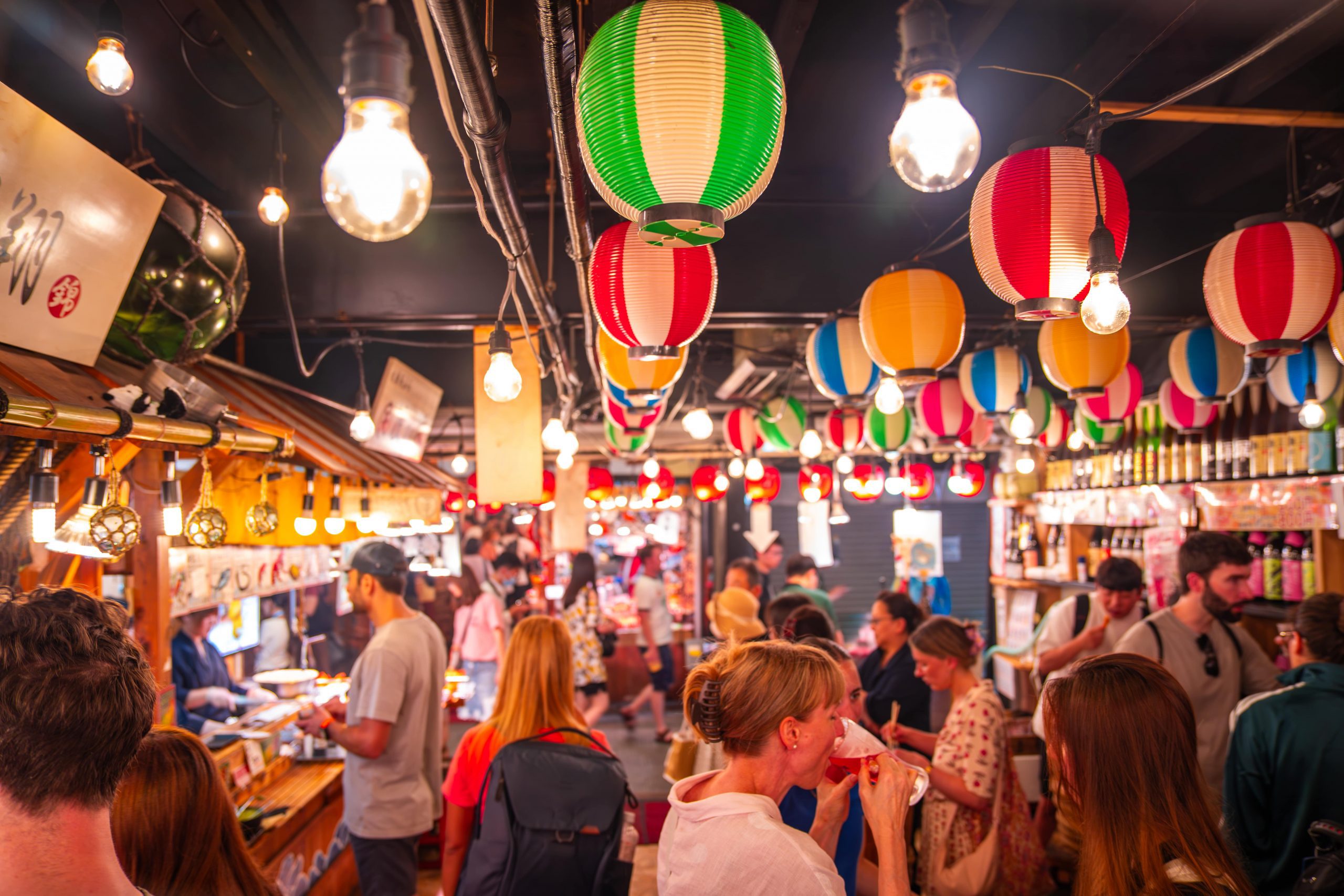
Nishiki Market in Kyoto.
Sample everything from freshly made senbei (rice crackers) to yatsuhashi (sweet cinnamon mochi), roasted chestnuts, skewered yakitori, and endless varieties of pickles and teas. Don’t miss tako tamago (baby octopus stuffed with quail egg), matcha-dusted sweets, grilled eel, and fluffy dashimaki tamago (Japanese rolled omelette). Seasonal specialities—like sakura mochi in spring or roasted sweet potatoes in autumn—highlight the best of each time of year. This is the place to be adventurous—let curiosity guide your taste buds.
Insider Tip: Many stalls are cash-only, so bring yen in small bills and coins.
22. Take a Sake Brewery Tour
Japan’s famed rice wine, Sake, is integral to its culinary culture. Each region has its own sake characteristics, influenced by the local water and rice. Tasting sessions allow you to learn about the brewing process and chat with local experts.

Eat Sushi with a taste of Sake is a delightful way to engage with Japan.
Top Regions: Fushimi (Kyoto), Nada (Kobe), and Niigata.
Insider Tip: Many breweries offer tours in English and welcome international guests.
23. Wander Tsukiji Fish Market & Take a Sushi-making class
The Tsukiji Fish Market, previously known as the world’s largest wholesale raw fish and seafood market, was a vibrant symbol of Tokyo’s dynamic culinary scene. Though the wholesale market moved to the new Toyosu Market in 2018, Tsukiji’s outer market, known as Tsukiji Jogai Shijo, continues to thrive, offering a rich array of fresh seafood, vegetables, and a variety of food stalls of Japanese food-related goods.

Tsukiji fish market and take a Sushi making class – things to do in Japan
The outer market is a bustling area where locals and tourists wander through narrow lanes with over 300 shops and stalls. Here, you can find an astonishing variety of seafood, from the freshest tuna to the most delicate uni (sea urchin). It’s not just seafood; the market also features convenience stores and offers a variety of kitchenware, groceries, and Japanese delicacies. The vibrant atmosphere, filled with the shouts of vendors and the scent of fresh food, makes for an exhilarating sensory experience.
Taking a Sushi Making Class:
Participating in a sushi-making class in or around Tsukiji is one of the things to do in Japan. These classes typically begin with a brief introduction to sushi’s history and the various types of sushi, followed by a hands-on experience where you learn to prepare sushi rice, select and cut fish, and assemble your sushi creations. You’ll then, of course, get to eat the fruits of your labour.

Participating in a sushi-making class is one of the things to do in Japan
If you’ve ever thought that you wanted to eat sushi at home but never had a chance to learn how to make it, now is your chance!
Expert Tips: Arrive early for the freshest food, and bring cash for the smaller stalls.
Seasonal & Festival Experiences
24. Admire The Cherry Blossom in Spring
Ask any traveller about their favourite experience in Japan, and you’ll likely hear about cherry blossom season. Each spring, from late March to early April, the country turns pink and white as sakura cherry blossoms bloom in parks, gardens, and along rivers.

Cherry blossoms are profound in Japanese history and culture.
Cherry blossoms are profound in Japanese history and culture. They are celebrated in countless poems, artworks, and songs, reflecting their deep symbolic meaning. The brief blooming period is a reminder of the fleeting nature of life, encouraging people to pause and appreciate the beauty around them. Historically, samurai and warriors were mainly connected to the symbolism of sakura, admiring their short-lived blooms as a metaphor for their lives.
Hanami – The Art of Flower Viewing: Hanami parties are a highlight of the cherry blossom season. Friends, family, and coworkers gather in parks, gardens, and along riverbanks, spreading out picnic mats under the blooming trees. These gatherings are festive and joyful, with people enjoying food, drinks, and the company of loved ones. The atmosphere is celebration and appreciation, with the blossoms providing a stunning canopy overhead. At night, many places offer yozakura, or nighttime cherry blossom viewing, where lanterns and lights illuminate the flowers, creating a magical and ethereal scene.
Expert Tips:
- Where to Go: Ueno Park and the Imperial Palace in Tokyo, Maruyama Park in Kyoto, and countless smaller spots across the country.
- How to Experience: Join locals for a hanami picnic, visit a traditional Japanese inn (ryokan) for a special sakura dinner, or simply stroll and let the petals fall around you.
25. Relax in an Onsen
In Japan, onsen (hot springs) and sento (public bathhouses) are not just bathing places but sanctuaries of relaxation and an integral part of the culture. These communal baths are a testament to the country’s volcanic activity, which provides a rich source of geothermal water, beneficial for relaxation and health. Immersing yourself in an onsen or sento is to experience a cherished Japanese tradition, offering a moment of tranquillity and a break from the fast pace of everyday life.

Relax in an Onsen is one of the things to do in Japan.
Onsens are scattered throughout Japan, from the northern island of Hokkaido with its snowy landscapes to the subtropical islands of Okinawa. Each hot spring has its own unique mineral composition, believed to provide different health benefits, such as relieving muscle pain, improving circulation, or soothing skin ailments. The settings of these hot springs vary widely, from outdoor baths (rotenburo) with panoramic views of mountains or forests to indoor baths in traditional ryokan (inns). Some are located in remote areas, offering a serene escape surrounded by nature, while others are part of luxurious spa resorts.
26. Stay in a traditional Japanese inn
Staying in a ryokan, a traditional Japanese inn, is a way to immerse yourself in Japan’s hospitality and aesthetic. Ryokans offer tatami-floored rooms and futon beds, often including kaiseki meals and a multi-course dinner showcasing seasonal and regional specialities. Many ryokans also have their own onsen, adding to the luxury. It’s an experience emphasising omotenashi, or Japanese hospitality, making you feel deeply connected to the culture and traditions.

Staying in a Ryokan is a way to immerse yourself in Japan’s hospitality and aesthetic.
- Kaiseki Meals: Savour a multi-course kaiseki meal, a culinary art form where each dish reflects the season and local ingredients.
- Hot Springs: Most ryokan offer onsen experiences—relaxing in mineral-rich hot springs, sometimes with views of Mt. Fuji or surrounded by gardens.
- Local Insight: Staff treat every guest with genuine care, helping with everything from yukata robes to travel planning tips.
- Where to Stay: Ryokans are found across Japan, but the best experiences are in Kyoto, Hakone, the Izu Peninsula, and mountain villages.
Hidden Gems in Japan
27. Visit an Animal Cafe in Tokyo
Animal cafes are a unique aspect of Tokyo’s urban culture, offering a moment of peace and companionship. Whether you choose a cat, an owl, or a hedgehog cafe, you’re in for a heart-warming experience. These cafes provide a break from the bustling city life and reflect Tokyo’s innovative and quirky side. Sip your coffee as a cat nuzzles against you or marvel at the grace of an owl up close. It’s an experience that combines relaxation with the joy of interacting with animals.

Cat Cafe in Shibuya, Tokyo.
28. Visiting a Sumo Tournament
Sumo tournaments, known as honbasho, are held six times a year across Japan, each lasting 15 days. The atmosphere at a sumo tournament is electric, with fans cheering for their favourite wrestlers. Watching live sumo is an exhilarating experience, offering a glimpse into the wrestlers’ power, technique, and strategy. The highest-ranked sumo wrestlers, particularly the Yokozuna (grand champion), are the main attractions, revered for their skill and presence.

Sumo wrestling is Japan’s national sport and a cultural.
29. Try out the Kendo class
Kendo, the way of the sword, is a traditional Japanese martial art form that offers a physical and mental challenge. Taking a kendo class allows you to experience this ancient practice’s discipline, technique, and spirit. It’s not just about learning to wield a bamboo sword; it’s about understanding the philosophy and respect that underpin martial arts in Japan. Whether you’re a beginner or experienced in martial arts, a kendo class is a unique way to connect with Japan’s warrior culture.

Kendo class is one of the things to do in Japan.
How to create your ideal trip
Planning a trip to Rising Sun country can be as exciting as the journey itself. With so many things to see and do, how do you create your ideal itinerary? It’s like piecing together a puzzle, where each piece represents an experience that will shape your journey. But don’t worry; we’ve got some tips to help you create your perfect trip.
Identify Your Interests
The first step in planning your trip is to identify your interests. Are you a history buff? A foodie? An adventure seeker? Are you a fan of anime? Identifying what you love will help you choose the experiences that will make your trip meaningful and enjoyable.
Do Your Research
Once you’ve identified your interests, it’s time to do some research. Look for places and activities that align with your interests. Read travel blogs, watch travel vlogs, check out travel guides, and use online travel platforms. The more information you have, the better choices you can make on what to do in Japan.
Prioritize
You can’t see and do everything, so you need to prioritise. Make a list of your must-see places and must-do activities. Consider factors like travel time, cost, and opening hours. Remember, it’s not about ticking off as many places as possible but making the most of each experience.
Be Flexible
While having a plan is good, it’s also important to be flexible. Allow some free time in your itinerary for spontaneous adventures. You never know what hidden gems you might discover along the way.
Book in Advance
For specific experiences, like staying in a famous ryokan or visiting a popular museum, booking in advance is advisable. This will ensure you don’t miss out on these experiences due to a lack of availability.
Creating your ideal Japan itinerary is not just about visiting popular tourist spots. It’s about choosing experiences that resonate with you, inspire you, and make you fall in love with the country. So, when planning your things to do in Japan, remember to craft your journey around your interests, passions, and dreams.
F.A.Qs
What are the must-do activities in Japan?
Explore Tokyo’s neighbourhoods, see Mt Fuji, stroll through bamboo forests, visit historic temples, relax in hot springs, stay at a traditional Japanese inn, sample street food, enjoy sushi restaurants, ride the bullet train, and immerse yourself in Japanese culture for an unforgettable experience.
How many days do I need to experience Japan properly?
For a meaningful Japan experience covering Tokyo, Kyoto, and key highlights, plan for 10-14 days minimum. Seven days works for a focused Tokyo-Kyoto trip, while 21+ days allows for regional exploration and deeper cultural immersion. Designer Journeys designers help optimise your available time, ensuring you experience quality over quantity rather than rushing through a checklist.
Is $5000 enough for a trip to Japan?
Yes, $5,000 is enough for a seamless 1–2 week trip with comfortable hotels, bullet train tickets, food, and immersive experiences. You can plan luxury ryokan stays, kaiseki meals, and guided tours for a truly unforgettable journey. Our Local Designers excel at budget optimisation, showing you where to splurge for extraordinary experiences and where free or low-cost alternatives deliver equal magic.
Can I customise this bucket list to match my travel style?
Absolutely — that’s the Designer Journeys approach. This bucket list serves as inspiration, not a rigid itinerary. Whether you’re passionate about food, seeking spiritual experiences, love outdoor adventures, or want family-friendly activities, our Japan-based local designers curate a personalised version matching your interests, timeline, and budget. Share what resonates with you, and your Local Designer will help you create your unique Japan story.
Final Thought
In conclusion, Japan is a land of contrasts and harmony, offering many things to do in Japan for all travellers. Whether it’s your very first Japan trip or you’re returning after your last trip, Japan offers endless possibilities for fun, discovery, and personal growth. And remember, the beauty of travel lies not just in the destinations but also in the experiences. So, create your ideal trip, embrace the adventures, and make memories that will last a lifetime. Sayonara, and happy travelling!
Ready to design, discover, and explore your Japan bucket list? Our expert team is here to help you plan every detail and support your journey with confidence, care, and true local insight. Together, let’s make your trip unforgettable.





